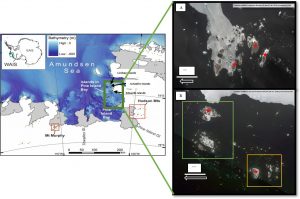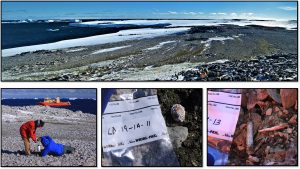
Looking into the recent history of Thwaites Glacier
Expedition Dates: January – March, 2019
Field Team Members: Scott Braddock1,2, Meghan Spoth1,2
- Climate Change Institute, 2. School of Earth and Climate Science – University of Maine
Expedition Funding: National Science Foundation award: PLR-1738989
Summary:
Accelerated ice retreat in recent decades for Thwaites and Pine Island glaciers of the West Antarctic Ice Sheet has raised fears of a run-away collapse of these glacial systems in the coming centuries and millennia. A massive effort involving many projects over the next five years, the International Thwaites Glacier Collaboration (ITGC), is now underway to understand past and present conditions related to ice fluctuations in the region because of the potential for these glaciers to significantly contribute to global sea-level rise. For two PIs on the larger project at the University of Maine, Dr. Brenda Hall and Dr. Seth Campbell, the goal is to use geological evidence to constrain past ice fluctuations and how those relate to changes going forward. This expedition is the first of three field seasons at Thwaites and our team collected samples from raised marine deposits on five islands and will date these samples to construct the first relative sea-level (RSL) curve for Pine Island Bay. A history of relative sea-level change in the region will provide long-term glacial isostatic uplift rates which are important parameters for ice sheet models that, ultimately, will be used to predict how quickly and how much ice will be lost in the future from these glaciers.
Project Goals:
The goal of this project is to construct a RSL curve for Pine Island Bay (PIB; Figure 1) that will afford insight into late-Holocene (past several thousand years) thinning of ice in the region. RSL variations represent perceived changes in local sea level due to the depression of land masses caused by the immense weight of advancing ice and subsequent rise of that land once ice thins and retreats. During this scenario, marine sediments, commonly in the form of beaches, are deposited along coastal areas. It is these beaches at different elevations that we target for sampling to collect material suitable for radiocarbon dating to create a history of RSL.
Past studies suggest that one of two scenarios must be true for Thwaites and Pine Island glaciers. Either their ice thickness has remained stable for the past 3,000-6,000 years or these glaciers were smaller than at present and have advanced to their current positions since that time. If evidence supports the latter scenario, then glaciers in this region were able to stabilize and readvance under climate conditions very similar to those of today and run-away collapse associated with the present ice thinning is not inevitable. An understanding of RSL variations during this period can afford critical information on former maximum ice thickness, timing of deglaciation and subsequent changes in ice thickness that can be correlated with other geologic evidence to document past ice fluctuations. Additionally, data of past ice history from geologic evidence are critical for any forward modeling efforts that simulate behavior of the West Antarctic Ice Sheet under different future warming scenarios.

Initial Results:
To construct a RSL curve for PIB, we collected nearly 300 samples of organic material (Adelie penguin bones, Weddell seal fur and shells; Figure 2) for radiocarbon dating from five islands located in three distinct island chains (Figure 1). Samples were mainly found in excavated pits or on the surface of raised beaches. Radiocarbon dating the material collected from the beaches will afford an approximate age of their formation. The ages of the beaches can then be plotted against their elevations to create a RSL curve. Samples will be processed during the summer of 2019 and results published in the subsequent year.

International Effort:
Several international teams participated on this cruise to Pine Island Bay, Antarctica. TARSAN, who studied physical oceanography, carried out several important missions including the successful launch of an AUV (below image) by a Swedish team from the University of Gothenburg. The AUV was launched below the Thwaites ice shelf and in deep troughs to collect fine-scale bathymetry plus hydrography and chemistry data. Additionally, a team from the University of St. Andrews in Scotland successfully fixed 1 Southern elephant seal and 11 Weddell seals with CTD-SRDLs to record and transmit behavioral and environmental data over the next year collected when the seals dive for food. THOR, a marine geology and geophysics team, focused on mapping the sea floor in front of Thwaites ice shelf for the first time as well as coring numerous sea-floor sites to create a record of environmental changes in the region spanning the past several thousand years. These are only a few examples of the projects carried out on this cruise and highlight the scale and significance of the ITGC over the next five years to better understand how quickly and how much of the Thwaites glacier system may retreat in the coming decades and centuries.

Media Outreach: Additional articles and reports about the wide range of science activities related to Thwaites Glacier that were carried out on this expedition can be found in the following articles by Rolling Stones journalist, Jeff Goodell and PRI’s The World reporter, Carolyn Beeler.
https://www.pri.org/people/carolyn-beeler
https://www.rollingstone.com/author/jeff-goodell/
Additional field team members: Kelly Hogan (BAS), Elizabeth Rush (NSF Writer in residence), Victoria Fitzgerald (University of Alabama) and James Kirkham (BAS)

